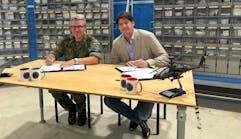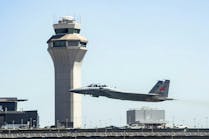First Military Remote Digital Tower in the United States Completes Systems Operation and Verification Test
The Frequentis’ Remote Digital Tower (RDT) system for the DoD has been installed, configured for use and is currently under assessment. RDT provides military air traffic controllers with an enhanced, digital “out-the-window” view incorporating a wide variety of sensors, digital data feeds and display augmentation, thus improving situational awareness and safety.
Frequentis is performing Remote Digital Tower activities under an OTA (Other Transaction Agreement) with the Naval Information Warfare Center (NIWC) Atlantic and in support of the US Air Force, US Navy and US Marine Corps. This system is the first military remote tower to be deployed within the DoD and will include the full range of Frequentis’ remote digital tower capabilities, including augmentation features such as data tags, bounding boxes and visual overlays. It is also the first time that a remote digital tower has been integrated with STARS (Standard Terminal Automation Replacement System) allowing controllers to see pertinent Radar display data overlaid on the panoramic out-the-window view.
“The successful completion of Systems Operation and Verification Test for our Remote Digital Tower is a major milestone for Frequentis and the DoD. As we move into Early Operational Assessment (EOA), it will be the first time that the US military will actively control aircraft using RDT technology. We will be working closely with our customer to gather user feedback and to ensure that the RDT system allows military air traffic controllers to carry out their duties with improved situational awareness and safety, supporting their missions,” said Leonard Swiontek, President, Frequentis USA.
Frequentis has been supporting the Department of Defense in the United States for a number of years, deploying and supporting Naval Air Traffic Control (ATC) for aircraft carriers and landing helicopter dock ships over the last seven years, as well as providing military ATC voice communications systems to Army airfields over the last three years.



